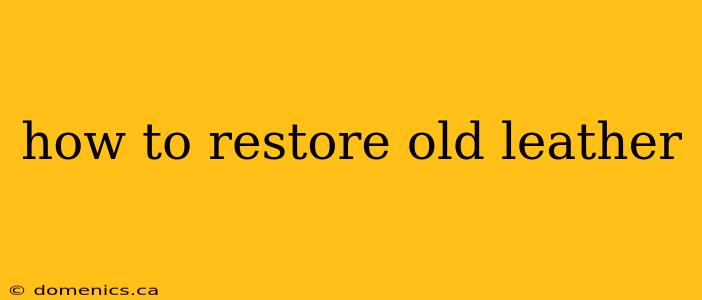Meta Description: Learn how to restore old leather to its former glory! This comprehensive guide covers cleaning, conditioning, and repairing techniques for all types of leather goods, from furniture to jackets. We'll cover everything from simple DIY solutions to professional-grade products, helping you revive your cherished leather items and extend their lifespan. Get started today and bring back the beauty of your leather!
Revitalizing Your Leather: A Step-by-Step Approach
Leather, a timeless material prized for its durability and beauty, can unfortunately show its age over time. Cracks, scratches, and discoloration are common issues. But don't despair! With the right approach, you can restore old leather to a remarkable state. This guide provides a comprehensive approach, covering everything from gentle cleaning to more intensive repairs.
1. Assess Your Leather and Gather Supplies
Before starting any restoration project, it's crucial to identify the type of leather you're working with. Full-grain leather is the most durable and requires less intensive care. Top-grain leather is more susceptible to damage. Knowing this will help you choose the appropriate cleaning and conditioning products.
Essential Supplies:
- Soft cloths: Microfiber cloths are ideal.
- Mild detergent: Dish soap or a specialized leather cleaner.
- Leather conditioner: Choose a product formulated for your leather type (e.g., saddle soap for tougher leathers).
- Leather repair kit (optional): For significant scratches or tears.
- Soft-bristled brush: To remove loose dirt.
- Vacuum cleaner (with brush attachment): For pre-cleaning.
2. Deep Cleaning Your Leather
Thoroughly clean your leather item before applying any conditioners. This removes dirt, grime, and oils that can prevent the conditioner from penetrating effectively.
Cleaning Process:
- Vacuum: Use a brush attachment to gently remove surface dust and debris.
- Wipe Down: Dampen a soft cloth with a mixture of mild detergent and warm water. Gently wipe the leather in small sections, ensuring the cloth isn't soaking wet.
- Rinse: Use a clean, damp cloth to remove any soap residue.
- Air Dry: Let the leather air dry completely. Avoid direct sunlight or heat.
3. Conditioning Your Leather: The Key to Softness and Longevity
Conditioning is vital for maintaining the suppleness and preventing cracking. This step replenishes the natural oils in the leather, restoring its flexibility and protecting it from further damage.
Conditioning Process:
- Apply Conditioner: Use a small amount of leather conditioner and apply it sparingly to a clean cloth.
- Rub In: Gently rub the conditioner into the leather in small circular motions.
- Buff: Once the conditioner is absorbed, buff the leather with a clean cloth to remove any excess.
- Let it Set: Allow the leather to absorb the conditioner completely before using the item. This may take several hours or overnight.
4. Repairing Scratches and Tears (If Necessary)
For minor scratches, a leather conditioner might suffice to fill them in. For more significant damage, a leather repair kit containing fillers and dyes might be necessary.
Repair Process:
- Clean the Area: Thoroughly clean the damaged area before applying any repair products.
- Fill the Scratch: Carefully apply the filler according to the kit's instructions.
- Let it Dry: Allow the filler to dry completely.
- Blend the Repair: Gently blend the repaired area with the surrounding leather using a soft cloth.
5. Maintaining Your Restored Leather
Regular cleaning and conditioning are crucial for maintaining the beauty of your restored leather. Aim to clean your leather items every few months and condition them at least once a year. Avoid exposing your leather to direct sunlight, heat, and moisture.
Professional Help for Severe Damage
For severely damaged leather items, such as those with significant tears or water damage, it’s best to consult a professional leather restoration specialist. They have the expertise and tools to handle intricate repairs.
Frequently Asked Questions (FAQs)
Q: What's the best leather conditioner? A: There isn't one "best" conditioner. The ideal choice depends on your leather type and its condition. Look for conditioners specifically designed for your leather type (e.g., full-grain, suede). Read reviews and consider trying a small amount on an inconspicuous area first.
Q: Can I use mink oil on all types of leather? A: Mink oil is a very heavy conditioner. While effective on some leathers, it can darken and damage others, particularly lighter-colored leathers. Use caution and test on a small hidden area first.
Q: How often should I condition my leather? A: Conditioning frequency depends on leather type, usage, and environmental conditions. As a general rule, conditioning once or twice a year is usually sufficient for most leather items. More frequent conditioning might be needed for items exposed to harsh conditions or heavy use.
By following these steps, you can effectively restore old leather and extend the life of your cherished leather goods. Remember, patience and care are key to achieving the best results.
